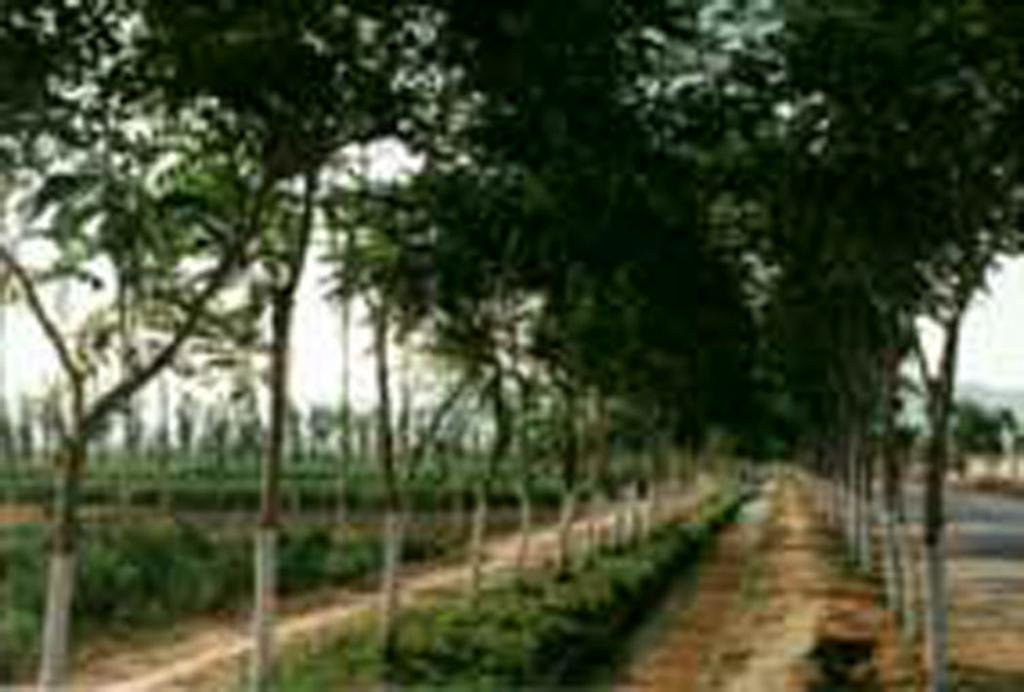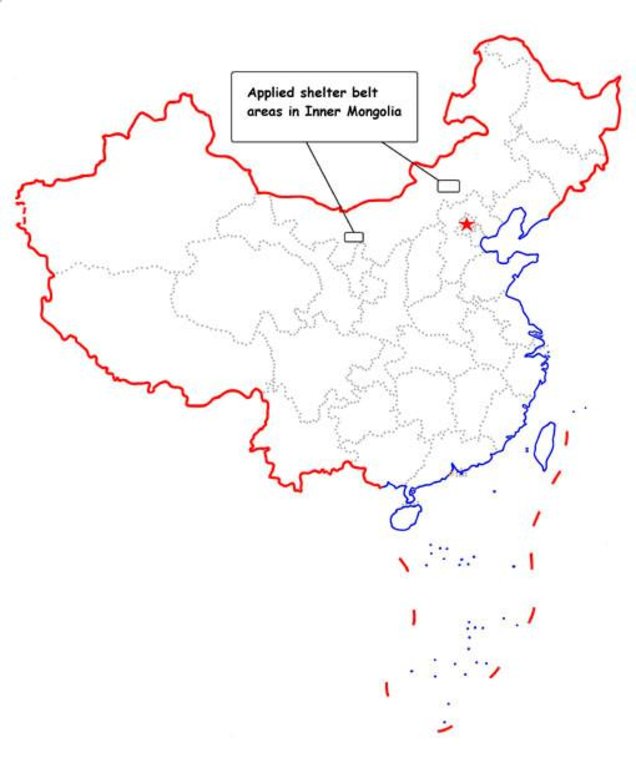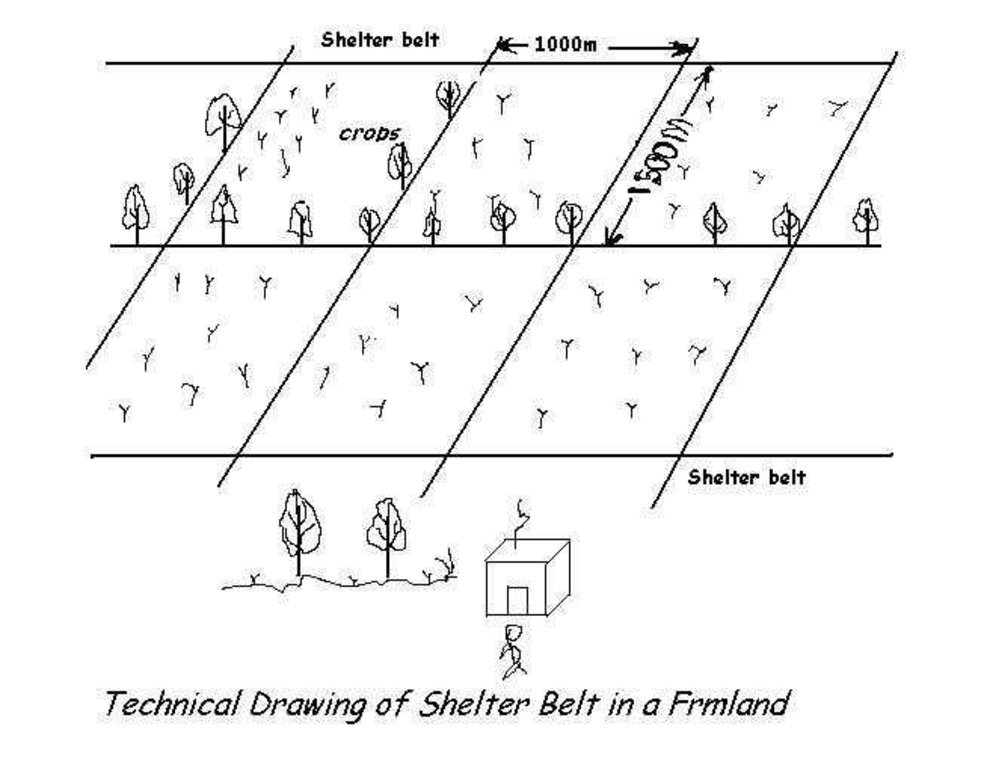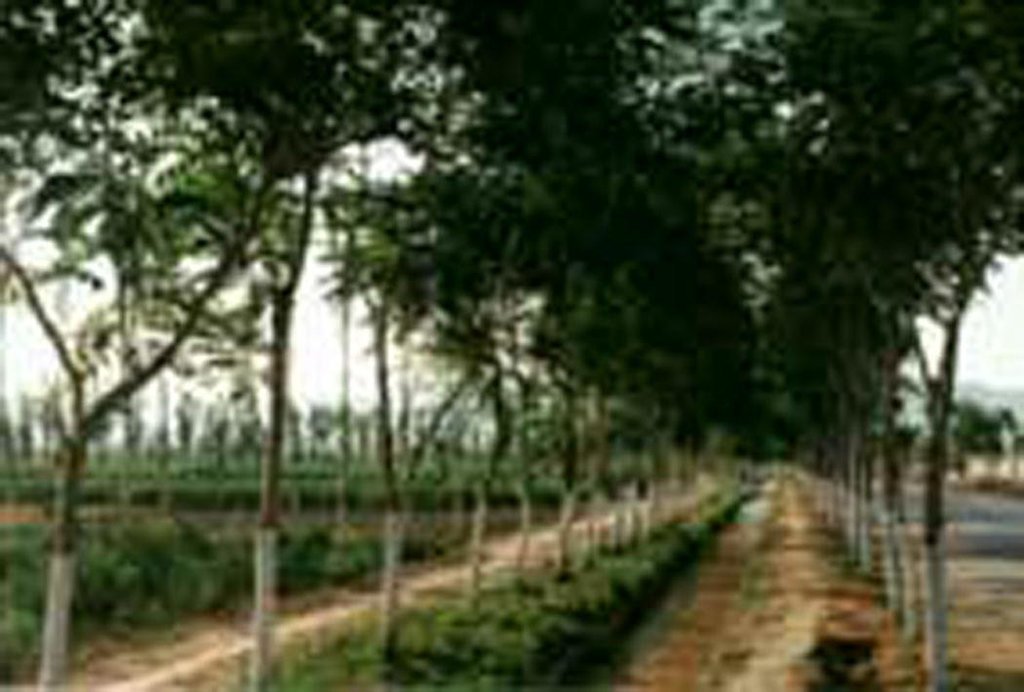Shelter Belt [China]
- Criação:
- Atualização:
- Compilador/a: Meili WEN
- Editor: –
- Revisor: David Streiff
approaches_2396 - China
Veja as seções
Expandir tudo Recolher tudo1. Informação geral
1.2 Detalhes do contato das pessoas capacitadas e instituições envolvidas na avaliação e documentação da abordagem
Nome da(s) instituição(ões) que facilitou(ram) a documentação/avaliação da Abordagem (se relevante)
Department of Resources and Environmental Science, Beijing Normal University (Department of Resources and Environmental Science, Beijing Normal University) - China1.3 Condições em relação ao uso da informação documentada através de WOCAT
O/a compilador/a e a(s) pessoa(s) capacitada(s) aceitam as condições relativas ao uso de dados documentados através da WOCAT:
Sim
1.4 Referência ao(s) questionário(s) sobre tecnologias da GST
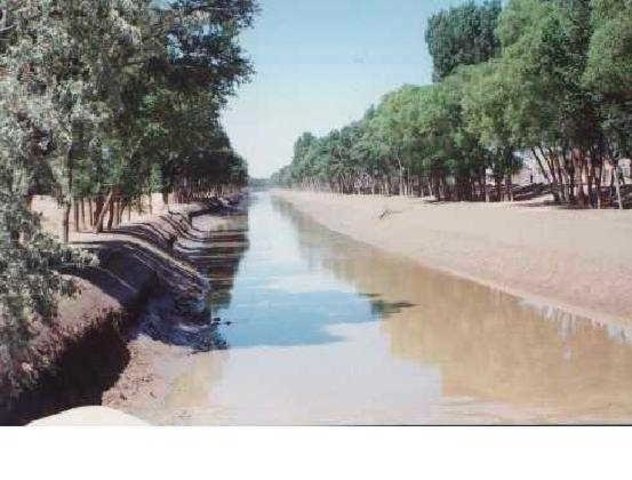
Shelterbelts for farmland in sandy areas [China]
Belts of trees, planted in a rectangular grid pattern or in strips within, and on the periphery of, farmland to act as windbreaks.
- Compilador/a: Meili WEN
2. Descrição da abordagem de GST
2.1 Descrição curta da abordagem
The shelter belt is a strip or a row of trees planted in a farmland as a wind barrier to protect crops and reduce wind erosion.
2.2 Descrição detalhada da abordagem
Descrição detalhada da abordagem:
Aims / objectives: Overall purposes are improving environment, and then realization sustainable development of agriculture. Specific objectives are decreasing wind erosion of cropland, increasing foodstuff production. When this approach is decided to implement, the first things to be done are to investigate natural and social-economic environment. Then scope and stages of implementation are decided by government with provision of capital and policies. After that, the approach need to propagandize to people who live in the project area. To implement this approach step by step, local government and land users play an very important role in implementation of the approach.
2.3 Fotos da abordagem
2.5 País/região/locais onde a abordagem foi aplicada
País:
China
Região/Estado/Província:
Inner Mongolia
Comentários:
The data is from: Inner Mongolia forest department. Inner Mongolia autonomy region forest statistic data, 1987, p75.
Map
×2.6 Datas de início e término da abordagem
Indique o ano de início:
1960
Ano de término (caso a abordagem não seja mais aplicada):
1981
2.7 Tipo de abordagem
- Baseado em projeto/programa
2.8 Principais metas/objetivos da abordagem
The Approach focused mainly on SLM with other activities (Modulation of air temperature, purifying air and increasing oxygen.)
The main objectives of the approach were reducing wind speed and keep soil moisture so as to be sustainable development of local land resources.
The SLM Approach addressed the following problems: Serious wind erosion in the farmland, and poor land management.
2.9 Condição que propiciam ou inibem a implementação de tecnologia/tecnologias aplicada(s) segundo a abordagem
Disponibilidade/acesso a recursos e serviços financeiros
- Inibitivo
No enough money
Treatment through the SLM Approach: Raising funds from different level of government
Quadro jurídico (posse de terra, direitos de uso da terra e da água)
- Inibitivo
Lack of enforcement of legislation
Treatment through the SLM Approach: Enforcement of legislation
The existing land ownership, land use rights / water rights moderately hindered the approach implementation Persuading land users to accept this SWC approach.
3. Participação e papel das partes interessadas envolvidas
3.1 Partes interessadas envolvidas na abordagem e seus papéis
- Usuários de terra/comunidades locais
Mongolian, Moslem, Korean minority nationalities, etc
Work equally divided between men and women
- Especialistas em GST/ consultor agrícola
A group of national and international specialists have been studying for a long time, and summarized this approach.
- Governo nacional (planejadores, responsáveis pelas decisões)
The implementing agencies are national government
3.2 Envolvimento do usuários de terra/comunidades locais nas diferentes fases da abordagem
| Envolvimento do usuários de terra/comunidades locais | Especifique quem estava envolvido e descreva as atividades | |
|---|---|---|
| Iniciação/motivação | Automobilização | public meetings; They were involved in approach by public meeting and understood the approach. |
| Planejamento | Participativo | ublic meetings; They involved approach by public meeting and understand the approach |
| Implementação | Automobilização | casual labour; They increased their income by participating casual labour |
| Monitoramento/avaliação | Participativo | interviews/questionnaires; They pronounced their point of view by interviews or questionnaires |
| Research | Participativo | They do not participate in. |
3.4 Decisão sobre a seleção de tecnologia/tecnologias de GST
Especifique quem decidiu sobre a seleção de tecnologia/tecnologias a serem implementadas:
- Políticos/líderes
Explique:
consultative.
Decisions on the method of implementing the SLM Technology were made by mainly by SLM specialists with consultation of land users. directive (top-down).
4. Suporte técnico, reforço das capacidades e gestão do conhecimento
4.1 Reforço das capacidades/ formação
Foi oferecida formação aos usuários da terra/outras partes interessadas?
Não
4.2 Serviço de consultoria
Os usuários de terra têm acesso a um serviço de consultoria?
Sim
Especifique se foi oferecido serviço de consultoria:
- nas áreas dos usuários da terra
Descreva/comentários:
On-the-job, farm visits, demonstration areas; Key elements: Quality of on-the-job, Effect of farm visits, Quality of demonstration areas; 1) Advisory service was carried out through: projects own extension structure and agents 2) Advisory service was carried out through: projects own extension structure and agents; Extension staff: mainly government employees 3) Target groups for extension: technicians/SWC specialists; Activities: Courses and demonstration
Advisory service is quite adequate to ensure the continuation of land conservation activities; All land users want to do this approach if they could get economic benefit from it. At each government level, there is a SWC division which is in charge of SWC activities including extension.
4.3 Fortalecimento da instituição (desenvolvimento organizacional)
As instituições foram fortalecidas ou estabelecidas através da abordagem?
- Sim, moderadamente
Especifique a que nível (níveis) as instituições foram fortalecidas ou estabelecidas:
- Local
Especifique o tipo de apoio:
- Financeiro
4.4 Monitoramento e avaliação
Monitoramento e avaliação são partes da abordagem?
Sim
Comentários:
bio-physical aspects were regular monitored by 0 through measurements; indicators: None
technical aspects were regular monitored by 0 through measurements; indicators: None
socio-cultural aspects were ad hoc monitored by 0 through observations; indicators: None
economic / production aspects were ad hoc monitored by 0 through measurements; indicators: None
area treated aspects were regular monitored by 0 through measurements; indicators: None
no. of land users involved aspects were ad hoc monitored by 0 through measurements; indicators: None
management of Approach aspects were ad hoc monitored by 0 through observations; indicators: None
There were few changes in the Approach as a result of monitoring and evaluation: Improving the approach according to the practical effect.
4.5 Pesquisa
A pesquisa foi parte da abordagem?
Sim
Especifique os tópicos:
- Economia/Marketing
- Ecologia
Dê mais detalhes e indique quem realizou a pesquisa:
This approach is applied for improving environment so as to relief their poverty.
Research was carried out on station
5. Financiamento e apoio material externo
5.1 Orçamento anual para o componente de GST da abordagem
Caso o orçamento exato seja desconhecido, indique a faixa:
- 10.000-100.000
Comentários (p. ex. principais fontes de recursos/principais doadores):
Approach costs were met by the following donors: international (-): 25.0%; government (national): 55.0%; international non-government (-): 7.0%; national non-government (-): 3.0%; local community / land user(s) (-): 10.0%
5.2 Apoio financeiro/material concedido aos usuários da terra
Os usuários da terra receberam apoio financeiro/material para a implementação de tecnologia/tecnologias?
Sim
5.3 Subsídios para entradas específicas (incluindo mão-de-obra)
- Equipamento
| Especifique quais entradas foram subsidiadas | Em que medida | Especifique os subsídios |
|---|---|---|
| Maquinário | Totalmente financiado | |
| Ferramentas | Totalmente financiado | |
- Agrícola
| Especifique quais entradas foram subsidiadas | Em que medida | Especifique os subsídios |
|---|---|---|
| Sementes | Totalmente financiado | |
| Fertilizantes | Totalmente financiado | |
| seedlings and biocides | Totalmente financiado | |
- Infraestrutura
| Especifique quais entradas foram subsidiadas | Em que medida | Especifique os subsídios |
|---|---|---|
| community infrastructure | Totalmente financiado | |
Se a mão-de-obra pelos usuários da terra foi uma entrada substancial, isso foi:
- Pago em dinheiro
Comentários:
Daily salary and materials as well as tools etc.
5.4 Crédito
Foi concedido crédito segundo a abordagem para atividades de GST?
Sim
Especifique as condições (taxa de juros, reembolso, etc):
Interest rate charged: 0.8%; repayment conditions: Varying every year, repayment is 5 years or 10 years..
Interest was lower than market rate.
6. Análise de impactos e declarações finais
6.1 Impactos da abordagem
A abordagem auxiliou os usuários da terra a implementar e manter as tecnologias de GST?
- Não
- Sim, pouco
- Sim, moderadamente
- Sim, significativamente
This approach has little relationship to improve soil and water management.
A abordagem melhorou as questões de posse de terra/diretos do usuário que inibiam a implementação das tecnologias de GST?
- Não
- Sim, pouco
- Sim, moderadamente
- Sim, significativamente
The policies of land contract distribute land to individuals so that land users who involved in SWC activities need to be organized together for implementation of the SWC. The organization need much time and hard work.
Did other land users / projects adopt the Approach?
- Não
- Sim, pouco
- Sim, moderadamente
- Sim, significativamente
A comprehensive SWC technology/approach has been formed based on the single measure such as shelter belt, terrace, check dams involved in agricultural development.
6.3 Atividades de sustentabilidade de abordagem
Os usuários da terra podem manter o que foi implementado através da abordagem (sem apoio externo)?
- Incerto
Caso negativo ou incerto, especifique e comente:
If there are not support from outside, land users couldn't will implement SWC approach.
6.4 Pontos fortes/vantagens da abordagem
| Pontos fortes/vantagens/oportunidades na visão do usuário da terra |
|---|
| Increasing their income (How to sustain/ enhance this strength: Increasing propagandizing and education about SWC knowledge.) |
| Pontos fortes/vantagens/oportunidades na visão do/a compilador/a ou de outra pessoa capacitada |
|---|
| Improving agricultural production conditions. (How to sustain/ enhance this strength: Reinforcing management to this approach) |
| Increasing the land users' income (How to sustain/ enhance this strength: Changing part cropland to cash crops or fuit trees so as to get much return and maintain the sustainable SWC approach.) |
6.5 Pontos fracos, desvantagens da tecnologia e formas de superá-los
| Pontos fracos/desvantagens/riscos na visão do usuário da terra | Como eles podem ser superados? |
|---|---|
| Poor mamagement after the shelter belt construction. | Enhancing management of village communities forbidding deforest. |
| Pontos fracos/vantagens/riscos na visão do/a compilador/a ou de outra pessoa capacitada | Como eles podem ser superados? |
|---|---|
| Cost much money and more labour forces | The government should increase fund to implement this kind of approach. |
7. Referências e links
7.1 Métodos/fontes de informação
- compilação de relatórios e outra documentação existente
7.2 Referências às publicações disponíveis
Título, autor, ano, ISBN:
China atlas.China atlas publishing house, 1999, p25.
Disponível de onde? Custos?
Library of the Department of Resource and Environmental Science, Beijing Normal University.
Título, autor, ano, ISBN:
Zhao Yu,Jing Zhengping, Shi Peijun, Hao Yunchong et al.Inner Mongolia soil erosion research remote sensing was used in Inner Mongolia soil erosion research,Science publishing house,1989, p25.
Disponível de onde? Custos?
Library of the Department of Resource and Environmental Science, Beijing Normal University.
Título, autor, ano, ISBN:
Inner Mongolia forest department, Forest work manual,1998,12, p33-34, p67
Disponível de onde? Custos?
Library of the Department of Resource and Environmental Science, Beijing Normal University.
Título, autor, ano, ISBN:
Synthesized investigate team in Inner Mongolia-Ningxia, CAS.West of northeast Forest in Inner Mongolia autonomy region, Science publishing house,1981, p82-101.
Disponível de onde? Custos?
Library of the Department of Resource and Environmental Science, Beijing Normal University.
Título, autor, ano, ISBN:
Sun Jinzhu. Natural condition and reconstruct in Hetao plain,Inner Mongolia people's publishing house,1976, p188-189.
Disponível de onde? Custos?
Library of the Department of Resource and Environmental Science, Beijing Normal University.
Título, autor, ano, ISBN:
Inner Mongolia forest Department. Inner Mongolia autonomy region forest statistic data,1987, p75.
Disponível de onde? Custos?
Library of the Department of Resource and Environmental Science, Beijing Normal University.
Título, autor, ano, ISBN:
Hu Chun(chief editor). Inner Mongolia autonomy region climate resources about agriculture, forest and animal husbandry, Inner Mongolia people's publishing house, 1984, p45-47.
Disponível de onde? Custos?
Library of the Department of Resource and Environmental Science, Beijing Normal University.
Título, autor, ano, ISBN:
Water and soil conservation bureau, Yellow River irrigation works committee of Department of water and electricity. Water and soil conservation economy benefit thesis collecting,1987, p45-47.
Disponível de onde? Custos?
Library of the Department of Resource and Environmental Science, Beijing Normal University.
Título, autor, ano, ISBN:
Sun Jinzhu,Chen Shan(chief editor). Inner Mongolia environmental alarm beforehand and repair countermeasure. Inner Mongolia people's publishing house,1994, p132.
Disponível de onde? Custos?
Library of the Department of Resource and Environmental Science, Beijing Normal University.
Links e módulos
Expandir tudo Recolher tudoLinks

Shelterbelts for farmland in sandy areas [China]
Belts of trees, planted in a rectangular grid pattern or in strips within, and on the periphery of, farmland to act as windbreaks.
- Compilador/a: Meili WEN
Módulos
Não há módulos



